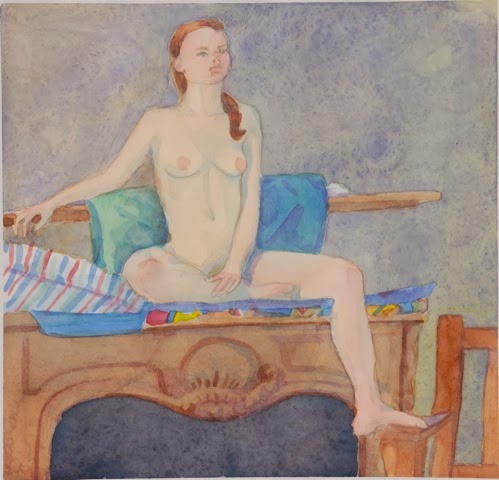Perspectives from a tabletop.
As I've had limited modeling work lately there hasn't been much variety in what I've been doing. At Loyola Marymount University's art studio there is a large rolling table in the middle of the room with a black pad set on top of it. This is where I have been doing all my modeling, and only one of the classes have included any sort of prop. For a couple months all my modeling has consisted of me on a table trying to think of interesting poses, wondering if I'm repeating the same one over and over.
This sort of work is challenging. I'm forced to be creative with subtle curves of the body to make the pose interesting, rather than depending on dynamic curves. Instead of hanging a leg over the end of a couch I have to discover the angle at which my hips will cause my one shoulder to rise a couple inches. However I appreciate the time learning how to form shapes with just my body.
I have decided I prefer to model with props, a single chair. I get to take on more interesting poses, and if I have something to prop me up (get it?), I can hold them for longer. A lot of what goes into a good pose is having some angle change. Often this can be the natural curve of the body, but the arc of an angled limb is a more exciting way to create interesting shapes in the pose. Without a chair, there is a trade off between standing and sitting. It's hard to make angles with your legs if you have to stand on them for ten minutes, or if you're sitting on them. There are things you can do to avoid this but having a chair to hang your legs off of makes it ten times easier, and the pose can be held longer.
 |
| This pose had three different levels to rest limbs on, giving a great variety of angle changes in the pose. Watercolor by Kim Grant |
Modeling with props also creates an opportunity for artists to explore the body interacting with objects. One of the classes I worked for at LMU was about how fabric hung or wrinkled on the body. That was one of the more entertaining classes I worked, pretending to text and drink coffee so the students could experiment with the body in a more casual setting. I think my preference for modeling with props stems from my enjoyment of work that shows the model in a situation.
These situations don't need to be "casual poses" with little props like cell phones and cups of coffee. I think the main attraction of using props is the aspect of inspiration. As when I model on the rocks and they direct me where to lie, any kind of prop can give an idea for a pose. Thinking of this emphasizes the idea that models need inspiration as well as artists. The aspect of the "muse," has always fascinated me, and working as a model has not deterred that interest. The most exciting modeling sessions I have are when I am inspired by the artist, not just the furniture around me. I suspect the spark of a "muse" relationship could lie in the moment when an artist and a model begin to inspire each other.

